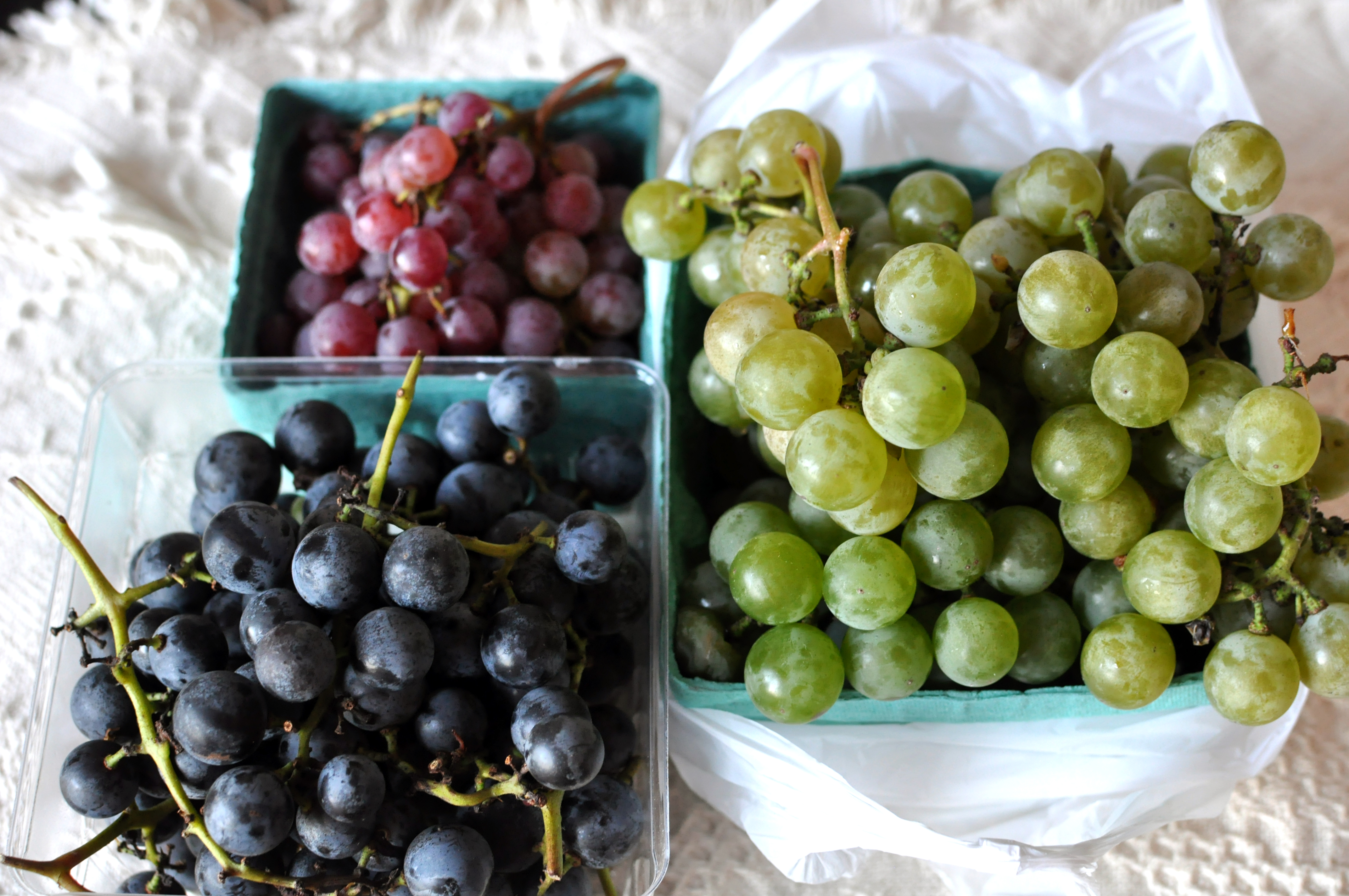If you’ve been to your local farmer’s market recently you’ll no doubt have been luxuriating in the wonderfully musky and candy-sweet scent emanating from just-harvested local grapes. Grapes that put their generic, bland grocery-store cousins to shame.
When I was down at Union Square green market last week, it seemed as if every bee within a 100-mile radius was also enjoying the juicy, ripe fruit. The little critters swarmed the stalls, settling on the grapes by the dozen. Still, I guess it’s only fair that we share, especially considering the bees are in (large) part responsible for the fruit in the first place!
Despite the challenges presented by our stripy friends, I picked up three local varieties of grapes, each one with its own unique flavor and aroma. A die-hard fan of grape jelly, I headed straight for the Concords with their perfectly round, rich purple-blue orbs. Then my nose took me to the pale, greenish-white Niagara grapes which have the most compelling scent I have ever encountered from a grape: deeply musky with robust honey and floral tones as well as hints of jasmine and citrus. Though they don’t look anything like each other, Niagara and Concord grapes are in fact related. The former was “created” in the 1860’s when Concord grapes were cross-bred with another white grape variety.
Both Niagara and Concords contain seeds – usually between 1 and 3, which are held in a gelatinous sac in the center of the fruit. They also both have what’s called a “slip skin” – which, as you’d expect, means that their skins easily slip off. When it comes to eating them, try squeezing the berry gently between two fingers until the skin comes away, then swallowing the pulp whole with the seeds intact. The skin can be quite tannic and sour, while the juice and flesh around the “seed sac”, just under the skin, are the sweetest parts of the grape.
If you plan on baking with these grapes – perhaps you want to make Melissa Clark’s Grape Focaccia, then you’ll need to de-seed them. I’m not going to lie to you, this is an arduous, laborious chore, but if you are in need of a mindless task to wile away some time, then grab a couple a bowls and a small, sharp paring knife. Simply halve the grapes and gently pry out the seeds with the tip of the knife being careful to catch any lost juice in a bowl placed underneath.
The third variety of grape I picked up was the pinkish-red Reliance. Being seedless, it’s ideal for eating out of hand, but is also great for use in jams, jellies, desserts (think pies thickened with tapioca, or cobblers and clafoutis), and even savory dishes. I made a spectacular chicken fricassee with these grapes, and white wine, mustard and bay leaves – but more on this later. Incidentally, this is a fantastic variety to grow in your garden since it’s hardy and vigorous, and grows quickly and abundantly, and requires little fuss. A mature vine will produce about 15-20 pounds of fruit every year.
Once picked, however, because of its high sugar content, Reliance, like Concord and Niagara grapes, are highly perishable- this is why you won’t see them in the grocery store. Once you take them home from the market, or after you’ve picked them, store in a sealed container, unwashed, in the fridge where they’ll keep for a week or two. But unlike other fruit, like bananas, they won’t continue to ripen after they’ve been picked, so be sure to taste a berry or two when you buy or pick the fruit to make it’s at its best. Wash just before using or eating by rinsing under cold running water.
Oh, and if there’s a white bloom on the grapes when you buy them, it’s nothing to worry about. This naturally occurring coating consists mostly of waxy oleanolic acid which helps protect the berries from moisture loss and decay.
3 Easy-Peasy Recipes for Grapes
For a tasty warm grape compote to spoon over ice cream, place stemmed and seeded or seedless grapes in a pan with a splash of water. Bring to the boil gently, then reduce to a gentle simmer. Continue to cook until the grapes begin to burst from their skins and soften. Remove from the heat, stir in a little sugar to taste, if desired, and serve warm.
For a sophisticated, multi-sensory dessert that requires virtually no culinary skill, place stemmed seedless or seeded grapes in a freezer-proof container. Freeze for a few hours until the fruit is fully frozen. Make a dark chocolate sauce by stirring finely chopped, good quality, bittersweet chocolate into heavy cream that has been brought to the boil in a pan and then removed from the heat. Once the chocolate sauce is completely smooth, stir in a little kirsch or brandy, or a pinch of chili powder, if desired, and transfer to a small jug. Remove the grapes from the freezer and divide into glasses. Pour the hot chocolate sauce over the frozen grapes at the table, and eat immediately.
For a light, flavorful and refreshing salad combine thinly sliced, trimmed endives with halved, seeded or seedless grapes, arugula and toasted walnuts. Crumble over some blue cheese, season with salt and pepper, and lightly combine. Pour over a dressing made from olive oil, cider vinegar and Dijon mustard, sweetened with a touch of maple syrup. Toss until well mixed.
Tags: concord, grapes, niagara, reliance
One Comment